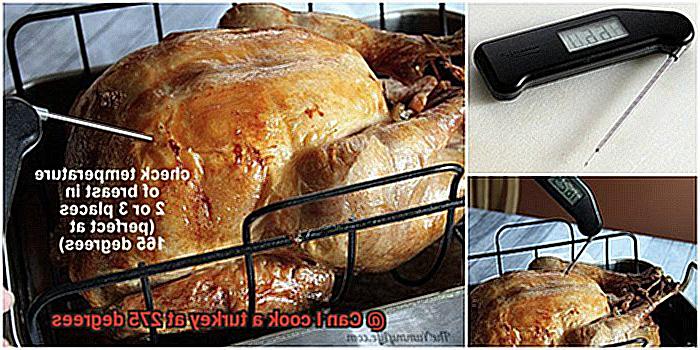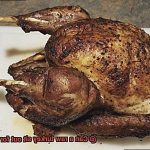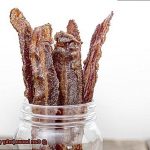Thanksgiving is almost here, and it’s time to start thinking about the main event: the turkey. But with so many cooking methods out there, it can be overwhelming to decide which one to choose. Should you crank up the heat for a crispy skin, or take it low and slow for juicy meat? And can you really cook a turkey at 275 degrees?
Let’s get down to brass tacks. Traditionally, turkeys are cooked at temperatures ranging from 325-350 degrees Fahrenheit. However, some cooks swear by the low and slow method, claiming that it results in a more evenly cooked bird. So why not give it a try?
But wait – what about food safety? Cooking a turkey at a lower temperature does increase the risk of bacteria growth. However, fear not. There are steps you can take to ensure that your turkey is safe to eat no matter what temperature you choose.
So here’s the answer: yes, you absolutely can cook a turkey at 275 degrees and still have it turn out delicious and safe to eat. In fact, there are some benefits to cooking at this lower temperature. But before you fire up your oven, there are some important factors to consider.
In this blog post, we’ll dive into the pros and cons of cooking a turkey at 275 degrees. We’ll also offer up some tips for ensuring that your bird turns out perfectly cooked regardless of the temperature you choose. Whether you’re an experienced chef or a first-time Thanksgiving host, read on for everything you need to know about cooking a turkey at 275 degrees.
Contents
Can You Cook a Turkey at 275 Degrees?
The answer is yes, but it requires patience and careful monitoring to ensure that the bird is fully cooked and safe to eat.
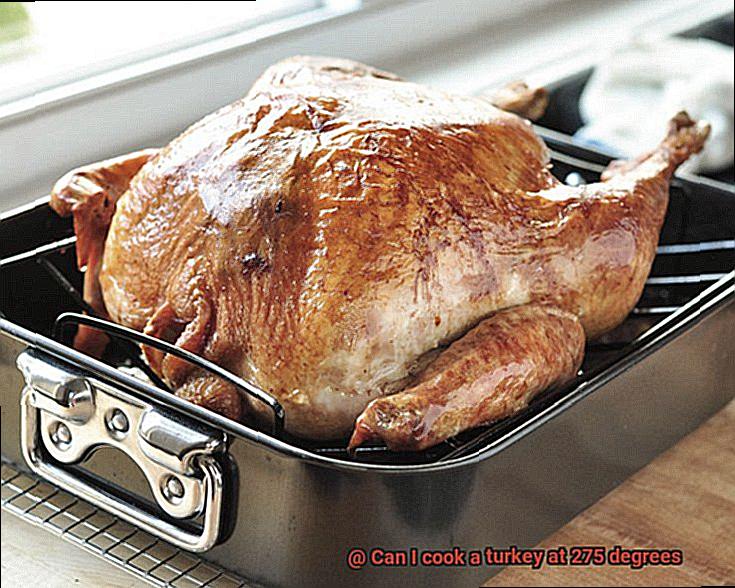
One benefit of cooking a turkey at a lower temperature is that it can result in a more evenly cooked bird with less risk of overcooking or drying out. Additionally, cooking at a lower temperature can help to retain moisture in the meat and save energy by reducing utility bills. However, it’s important to note that cooking a turkey at 275 degrees may not result in crispy skin, which some people prefer.
When cooking a turkey at a lower temperature, it’s essential to use a meat thermometer to ensure that the bird reaches the safe internal temperature of 165 degrees Fahrenheit throughout the bird. It’s also recommended to use a roasting pan with a rack to allow for air circulation and prevent the turkey from sitting in its juices. This will help prevent bacterial growth and food poisoning.
Despite these benefits, there are some challenges to consider when cooking a turkey at 275 degrees Fahrenheit. One of the main challenges is the longer cooking time required to reach the minimum safe internal temperature of 165 degrees Fahrenheit throughout the bird. Additionally, there is an increased risk of bacterial growth and food poisoning if the bird is not cooked thoroughly.
Why Is Cooking a Turkey at 275 Degrees Not Recommended?
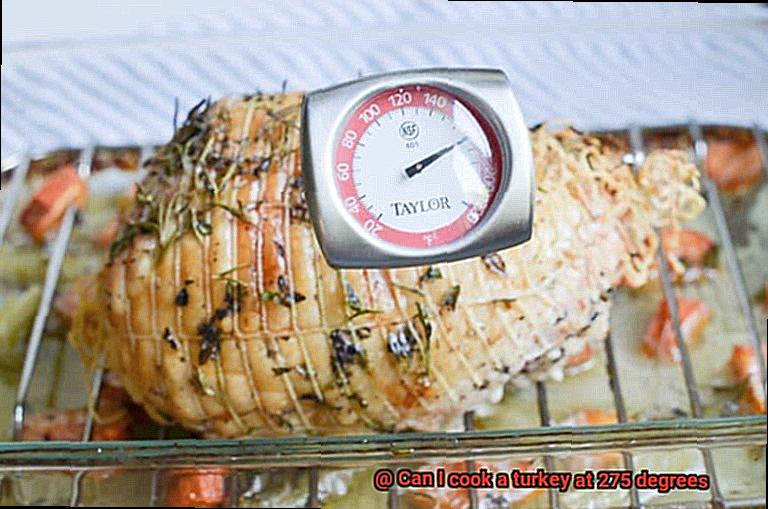
While you may be tempted to cook it at a lower temperature to save energy or enjoy a longer cooking time, I strongly recommend against cooking a turkey at 275 degrees Fahrenheit. Here are the reasons why:
Firstly, cooking a turkey at a low temperature increases the risk of foodborne illness. Nobody wants to fall ill after enjoying a delicious meal. According to the USDA, a turkey needs to be cooked to an internal temperature of 165 degrees Fahrenheit to kill harmful bacteria such as salmonella and campylobacter. When you cook at a lower temperature, the turkey spends more time in the “danger zone” where bacteria can grow rapidly.
Secondly, cooking a turkey at 275 degrees can lead to uneven cooking. Dry and overcooked outer layers, along with undercooked inner parts, can result in an unappetizing and tough bird. This happens because it takes several hours for the turkey to reach the desired internal temperature at this low temperature.
Lastly, cooking a turkey at a low temperature can impact its texture. Turkey is known for being lean meat, which means it doesn’t have much fat to keep it moist during cooking. Cooking at a higher temperature allows the fat to melt and provide moisture to the meat. Cooking at 275 degrees Fahrenheit means that the moisture is not released as quickly, resulting in drier and tougher meat.
What Are the Risks of Cooking a Turkey at 275 Degrees?
Thanksgiving is just around the corner, and you may be tempted to take a different approach to cooking your turkey this year. But before you decide to cook your bird at 275 degrees Fahrenheit, it’s important to understand the risks associated with this method.
Firstly, cooking a turkey at a lower temperature increases the chances of bacteria growth. Bacteria love temperatures between 40 and 140 degrees Fahrenheit, and cooking your turkey at 275 degrees Fahrenheit may not be hot enough to kill off all the bacteria present in the meat. This could lead to foodborne illnesses that could ruin your holiday.
Secondly, cooking a turkey at such a low temperature can result in uneven cooking. The outside of the turkey may be cooked while the inside remains raw or undercooked. This can be dangerous as consuming undercooked meat increases the risk of food poisoning. Plus, who wants to deal with uncooked turkey on Thanksgiving day?
Thirdly, cooking a turkey at 275 degrees Fahrenheit can result in dry and tough meat. The low temperature means that the moisture in the meat evaporates slowly, leaving you with unappetizing dry meat that takes forever to chew. And let’s not forget about the skin – it won’t crisp up at this temperature, leaving you with rubbery skin that no one wants to eat.
Lastly, cooking a turkey at such a low temperature can also affect the flavor of the bird. Without the Maillard reaction, which gives cooked food its rich flavor, your turkey may taste bland and unexciting. After all, who wants to spend time cooking a Thanksgiving meal only to have it taste disappointing?
How Long Does it Take to Cook a Turkey at 325-350 Degrees Fahrenheit?
Thanksgiving is fast approaching, and you are likely preparing to cook a turkey for your holiday feast. The process of cooking a turkey requires careful consideration of temperature and time. Cooking a turkey at a lower temperature of 275 degrees Fahrenheit may seem like a good option, as it can make the meat more tender and juicy. However, it increases the risk of foodborne illnesses due to the longer cooking time.
The recommended temperature range for cooking a turkey is between 325-350 degrees Fahrenheit. At this temperature range, it takes approximately 15-20 minutes per pound of turkey to cook. So, if you have a 10-pound turkey, it would take around 2.5-3.5 hours to cook. Keep in mind that every oven is different, and factors such as altitude and humidity can affect cooking times as well.
To ensure that your turkey is safe to consume, use a meat thermometer inserted into the thickest part of the meat without touching any bone. The internal temperature of the turkey should reach 165 degrees Fahrenheit. This will give you peace of mind knowing that your turkey is fully cooked and safe to eat.
Some people may be tempted to experiment with a lower cooking temperature, but it’s not worth the risk. Cooking a turkey at 275 degrees Fahrenheit can prolong cooking time by up to an additional hour or more, increasing the risk of bacteria growth that can cause food poisoning if not cooked correctly.
Is There an Alternative Method for Cooking a Turkey At Lower Temperatures?
Thanksgiving is just around the corner, and if you’re looking to cook your turkey at a lower temperature, you may be wondering if there are alternative methods available. Fear not, as there are several techniques that can help you achieve the desired result. As an expert in this area, I have done some research and want to share with you the different ways you can cook a turkey at lower temperatures.
Let’s start with the Sous Vide method. This technique involves cooking the turkey in a vacuum-sealed bag in a water bath at a precise temperature. This method ensures even cooking of the turkey and results in a moist, tender bird. Sure, it requires some special equipment, but it’s definitely worth considering if you’re looking for an alternative to traditional oven-roasting.
Another option is to cook your turkey on a smoker or grill using indirect heat. This method requires some preparation and patience, but the results are worth it – think smoky, flavorful turkey with crispy skin. To achieve this, set up your smoker or grill for indirect heat and use wood chips or chunks to add smoke flavor to the bird. Remember to monitor the temperature of your bird using a meat thermometer to ensure that it’s fully cooked.
If you don’t have access to a smoker or grill, slow cooking is another option. Simply place your seasoned turkey in a slow cooker with some liquid and let it cook on low heat for several hours until it reaches the safe internal temperature of 165 degrees Fahrenheit. While this method may not produce crispy skin like other methods, it does result in a moist and tender turkey that’s easy to carve and serve.
What are the Benefits of Cooking a Turkey At Higher Temperatures?
There is a solution to this age-old problem – cooking your turkey at a higher temperature. But before you turn up the heat, let’s explore the benefits and potential downsides of this method.
Firstly, one of the most significant benefits of cooking your turkey at a higher temperature is that it can result in a perfectly crispy skin. The high heat helps to render the fat under the skin, giving it that beautiful golden brown color and crispiness that we all crave. Additionally, this method can shorten cooking time, meaning more time to spend with family and friends on Thanksgiving day.
However, there are some potential downsides to consider as well. Cooking your turkey at a higher temperature can cause the moisture in the meat to evaporate more quickly, resulting in dry and tough meat. Additionally, there is a risk of overcooking or burning the outside while leaving the inside undercooked.
To ensure success, it is essential to monitor your turkey closely while cooking at a higher temperature. Be sure to check the internal temperature with a meat thermometer regularly and baste the turkey frequently to prevent it from drying out.
How Can I Ensure My Turkey is Safely Cooked Through?
As an expert in the field, I have gathered some tips to help you ensure that your turkey is safely cooked through.
First and foremost, it is crucial to follow proper cooking guidelines. To guarantee that your turkey is safe to eat, cook it to an internal temperature of 165 degrees Fahrenheit. You can measure the temperature in the thickest part of the bird, such as the thigh or breast. Although cooking a turkey at lower temperatures like 275 degrees Fahrenheit may take longer, it can still be done safely as long as the internal temperature is reached. Use a meat thermometer to check the temperature frequently throughout the cooking process.
If you’re considering stuffing your turkey, think again. Stuffing can increase cooking time and make it more difficult to reach the proper internal temperature. Instead, cook your stuffing separately and serve alongside the turkey.
Before you even start cooking, it’s important to thaw your turkey properly. A frozen turkey should be thawed in the refrigerator for several days before cooking. If you’re pressed for time, you can also thaw it in cold water or in the microwave – just make sure not to leave it out at room temperature.
Last but not least, handle raw turkey with care and follow proper food safety guidelines. This includes washing your hands and surfaces thoroughly after handling raw poultry and avoiding cross-contamination with other foods.
In summary, here are some key takeaways to ensure that your turkey is safely cooked through:
- Cook your turkey to an internal temperature of 165 degrees Fahrenheit
- Use a meat thermometer frequently throughout the cooking process
- Avoid stuffing your turkey
- Thaw your turkey properly before cooking
- Handle raw turkey with care and follow proper food safety guidelines
rm-1yhG1uvE” >
Conclusion
In summary, while cooking a turkey at 275 degrees Fahrenheit is possible, it’s important to take precautions to ensure food safety. While this method can result in a more evenly cooked bird with less risk of overcooking, there are increased risks of bacterial growth and longer cooking times required to reach the safe internal temperature of 165 degrees Fahrenheit.
To ensure that your turkey is fully cooked and safe to eat, use a meat thermometer and consider using a roasting pan with a rack for air circulation. If you’re looking for alternative methods to cook your turkey at lower temperatures, Sous Vide cooking or smoking on a grill using indirect heat are great options. Slow cooking in a slow cooker is also an option.
On the other hand, cooking your turkey at higher temperatures can result in deliciously crispy skin and shorter cooking times. However, it’s crucial to monitor your turkey closely to prevent dry and tough meat or burning the outside while leaving the inside undercooked.
No matter what temperature you choose, following proper food safety guidelines such as thawing your turkey properly, avoiding cross-contamination with other foods, and handling raw poultry carefully is essential.

